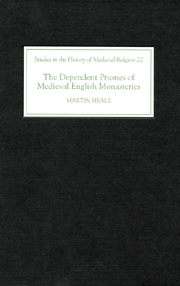Book contents
- Frontmatter
- Contents
- List of Figures and Tables
- Dedication
- Acknowledgements
- Abbreviations
- Maps: The Dependent Priories of the Monasteries of Medieval England (England and Wales)
- Introduction
- Part I The Dependent Priory as Daughter House
- 1 The Foundation of English Cells
- 2 The Constitutional Affairs of English Cells
- 3 ‘A Source of Weakness’? Mother Houses and their Daughters
- Part II The Dependent Priory as Small Monastery
- Appendices
- Select Bibliography
- Index
- Other Volumes in Studies in the History of Medieval Religion
1 - The Foundation of English Cells
from Part I - The Dependent Priory as Daughter House
Published online by Cambridge University Press: 12 September 2012
- Frontmatter
- Contents
- List of Figures and Tables
- Dedication
- Acknowledgements
- Abbreviations
- Maps: The Dependent Priories of the Monasteries of Medieval England (England and Wales)
- Introduction
- Part I The Dependent Priory as Daughter House
- 1 The Foundation of English Cells
- 2 The Constitutional Affairs of English Cells
- 3 ‘A Source of Weakness’? Mother Houses and their Daughters
- Part II The Dependent Priory as Small Monastery
- Appendices
- Select Bibliography
- Index
- Other Volumes in Studies in the History of Medieval Religion
Summary
The daughter house is as old as cenobitic monasticism itself. The first communal Christian monastery, established at Tabennisi in Egypt by Pachomius (286–346), soon became the head of a small but tightly-knit group of houses founded as its offshoots. Yet although this structure held together after Pachomius' death, it does not seem to have greatly influenced the development of Eastern monasticism. In the West, too, independent monasteries predominated. The first Frankish Council at Orléans in 511 and subsequent councils forbade the grouping together of monasteries under a single abbot, and the Rule of St Benedict (c.530×540) made no mention of monastic affiliation. However, in societies characterised by overlordship, the principle of the mother church held considerable appeal. Where a single founder of sanctity established a number of monasteries, it was natural for each house to acknowledge the headship of the saint's own abbey. Monastic federations of this kind were particularly common in Irish monasticism and were spread widely by St Columbanus and other missionaries. Very little evidence survives about the strength and endurance of the ties that bound Irish houses together and it is quite possible that many affiliations were loose and fleeting. Rather more is known about the Ionan federation of houses, largely from Adomnán's Life of St Columba. Iona possessed several daughter houses, all of St Columba's foundation, on both sides of the Irish Sea. The saint is shown appointing and recalling heads of these satellites, and there is some evidence to suggest that St Columba and his successors as abbots of Iona made visitations of their daughter houses.
- Type
- Chapter
- Information
- The Dependent Priories of Medieval English Monasteries , pp. 15 - 63Publisher: Boydell & BrewerPrint publication year: 2004



